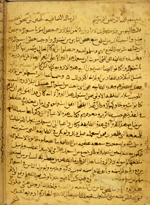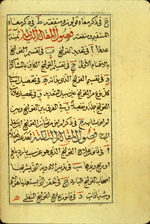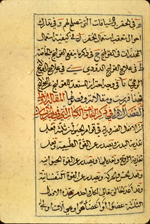Catalogue: Medical Therapeutics
-
 al-Risālah al-Shāfiyah fi adwiyat al-nisyān (MS A 3/II, item 1)
al-Risālah al-Shāfiyah fi adwiyat al-nisyān (MS A 3/II, item 1) - (The Salutory Treatise on Drugs for Forgetfulness)
- الرسالة الشافية فى ادوية النسيان
- or
- al-Maqālah al-Shāfiyah al-wajīzah fī al-ashyā’ allatī tufīdu al-ḥifz wa-tamna‘ al-nisyān wa-tajūdu al-dhihn wa-taḥfazu al-ṣiḥḥah
- (The Concise Salutory Chapter on Things Which Benefit the Retention of Memory and Prevent Forgetfulness and Improve the Intellect and Preserve Soundness [of Mind])
- المقالة الشافية الوجيزة فى الاشياء التى تفيد الحفظ وتمنع النسيان وتجود الذهن وتحفظ الصحة
- by Isḥāq ibn Ḥunayn (d. 910/298)
- اسحق ابن حنين
This treatise attributed to Isḥāq ibn Ḥunayn is the earliest preserved treatise on the topic of remedies for the loss of memory.
The title page and the final sentence ascribes the text to Isḥāq ibn Ḥunayn, but the beginning of the treatise itself (fol. 1b) states that it is by his father, Ḥunayn ibn Isḥāq. Galen is often cited as a source for the recipes and procedures recommended to treat forgetfulness, and Hippocrates gets one mention.
There is only one additional recorded copy of the Arabic treatise, but its present location is unknown, having been in a private collection in Aleppo early in the 20th century. See Sezgin, GAS III, p. 268 no. 4; and Paul Sbath, Al-Fihris (Catalogue de Manuscripts Arabes). Première partie: Ouvrages des Auteurs antérieurs au xviie siècle (Cairo 1938) p. 28 no. 193.
There is, however, an anonymous Hebrew translation which is preserved in two manuscripts in Munich (MS Heb. 275, fols. 16b-17b, copied in 1483 by Elasar Parnas, and MS Heb 302, fols. 259a-260a, copied in 1484-1485). The Hebrew version differs considerably from the Arabic original. See Gerrit Bos, "Baladhur (Marking-Nut): A Popular Medieval Drug for Strengthening Memory," Bulletin of the School of Oriental and African Studies (1996) vol. 49, pp. 229-236, for a discussion of the Arabic and Hebrew versions and selected paragraphs translated into English (based for the most part on the Hebrew versions).
The treatise has not been published or translated, except for the portions included in the study by Gerrit Bos.
al-Risālah al-Shāfiyah fi adwiyat al-nisyān / al-Maqālah al-Shāfiyah al-wajīzah fī al-ashyā’ allatī tufīdu al-ḥifz wa-tamna‘u al-nisyān wa-tajūdu al-dhihn wa-taḥfazu al-ṣiḥḥah (MS A 3/II, item 1)
Illustrations
The opening of an Arabic treatise on cures for forgetfulness attributed in the title page and at the end of the treatise to Isḥāq ibn Ḥunayn. The copy is undated, probably 13th or 14th century.
Physical Description
Arabic. 4 leaves (fols. 1a-4a [old 3a]). Dimensions 17.2 x 13.1 (approx. text area 15 x 10.5) cm; 21 lines per page. The title is given on the title page, fol. 1a. The author is given as Isḥāq ibn Ḥunayn al-tabib on both the title page (fol. 1a) and the end of the treatise on fol. 4a, line 19. However, at the start of the treatise itself (fol. 1b, line 1) the author is given as Ḥunayn ibn Isḥāq al-mutatabbib and the title as al-Risālah al-Shāfiyah. At the end of the treatise (fol. 4a [old 3a], lines 19-20) the title is given as al-Maqālah al-Shāfiyah al-wajīzah fī al-ashyā’ allatī tufīdu al-ḥifz wa-tamna‘u al-nisyān wa-tajūdu al-dhihn wa-taḥfazu al-ṣiḥḥah (The Concise Salutory Chapter on Things Which Benefit the Retention of Memory and Prevent Forgetfulness and Improve the Intellect and Preserve Soundness [of Mind])
The copy is undated and unsigned. The appearance of the paper, script, and ink suggests a date of the 13th or 14th centuries.
The text is written in a compact naskh script in brown-black ink. The text area has not been frame-ruled and the lines are irregularly positioned. Many of the diacritical dots are missing, the initial kaf often is missing the top stroke, and the letter sin sometimes has a caron over it. There are catchwords.
There are marginalia along the inside edge of the title page (fol. 1a) and around three edges of fol. 2a [old 1a]. The title page also has a seven-lines pious inscription giving a profession of faith, written in very large naskh script, and two vertical inscriptions written either side of the title. Of these vertical annotations, the one on the right is a response to a query made to "some learned men" (ba‘d a-hukama') regarding weeping and sobbing (nashaj), excessive fear (hirs), and cowardice (jubn) in which it is said that they are of the same nature (tabi‘ah) and should be treated together; the one on the left is an invocation to God.
The opaque biscuit paper is water damaged, especially near the edges, and there are areas within the text area that are damaged and illegible. The folios have been trimmed from their original size, occasionally cutting off parts of the marginalia.
The volume consists of 8 folios and one end leaf. There is an earlier foliation in Arabic numerals which omits to number the first folio and places Arabic numerals 1-7 on what are fols. 2-8 in the recent foliation. Item 1 (fols. 1a-4a [old [1]a-3a]) is the treatise here catalogued; item 2 (fols. 4b-7a line 14 [old 3b-6a]) is an untitled collection of drug recipes by Ibn Samajūn (MS A 3/II, item 2); and item 3 (fols. 7a-8b [old 6b-7b]) is the treatise on weakness of vision by Ibn Wāfid al-Lakhmī (MS A 3/II, item 3). The end leaf, of slightly different paper, has casually written notes, the first being eight lines, with some words marked out, on an unidentified topic; beneath the eight lines a different hand has written an account (that extends to both sides of the leaf) of a procedure for making an effective purgative (tuhr) employing various earths; the account begins with the date (tarikh) of 8 Rajab 981 [= 2 November 1573].
Binding
The collection of three treatises is bound together with another manuscript, copied at the end of the 15th century which contain two items concerned with compound remedies (designated MS A 3/I). The 8 leaves of MS A 3/II had separate foliation in Arabic numerals and are considerably older that the manuscript with which it is bound; were the volume to be foliated straight through, then these eight leaves and one end leaf would be counted as fols. 70-78 of the bound volume.
Provenance
On fol. 8b [old 8b] one al-Ḥājj ‘Abd Allāḥ al-‘Attar has added a note (upsidedown on the page) that he closed the accounts of one Ḥasan al-Khanī at the end of the month Rabi‘ I in the year [-]39 (the century is not specified); and different later owner has dated a procedure for making an effective purgative the 8th of Rajab 981 [= 2 November 1573].
The volume was purchased in 1941 by the Army Medical Library from A.S. Yahuda, who acquired it from a dealer in Mosul in Iraq (ELS no. 1750; Med. 51).
References
Schullian/Sommer, Cat. of incun. & MSS., entry A3, p. 298, ascribes authorship to an otherwise unknown Hamir ibn Ishaq.
Hamarneh, "NLM", p. 83, who states that "Others have suggested that it was written by Galen and translated by Ishaq"; no sources are supplied for this statement.
Sezgin, GAS III, p. 268 no. 4
NLM Microfilm Reel: FILM 48-110 no. 3.
-
 Kitāb al-Qawlanj (MS A 55)
Kitāb al-Qawlanj (MS A 55) - (The Treatise on Colic)
- كتاب القولنج
- by Abū ‘Alī al-Ḥusayn ibn ‘Abd Allāh Ibn Sīnā (Avicenna) (d. 1037/428)
- ابو على الحسين ابن عبد الله ابن سينا
This treatise by Avicenna is devoted to the symptoms and treatment of abdominal pain and colic (though some interpret the word qawlanj to refer also to ileus, or the obstruction of the intestine). The author states that the purpose is to discuss accurately the nature of colic (hal al-qawlanj) and its types, causes, characteristics, symptoms, and treatment. The treatise is in 3 chapters (maqalahs): the first on the anatomy and function of the stomach and intestines, in 9 sections (fasls); the second on the types, causes and symptoms of colic, in 8 sections (fasls); and the third on the treatment of colic, in 11 fasls. The treatise was dedicated to al-Amir al-Jalil Nasr al-Dawlah (Nasr al-Dawlah Aḥmad), who ruled Diyarbakr in upper Iraq from 1010 to 1061.
There are five other recorded copies of this treatise: in Rampur (India), Hyderabad (India), Tehran (Iran), Suhaj (Egypt), and in London (Wellcome Library for the History and Understanding of Medicine).
The copies in Tehran and Suhuaj were used in a modern edition prepared by Subhi Mahmud Hammami and published on pp. 145-175 of a volume in which he also edited a treatise on the same topic by al-Razi: Al-Razi, Kitab al-Qulanj (Le livre de la colique), edition critique et traduction, ed. and trans. by Subhi Mahmud Hammami [Masadir wa-dirasat fi ta'rikh al-tibb al-‘arabi, 4] (Aleppo, Syria: Ma‘had al-turath al-‘ilmi al-‘arabi, 1983). A second edition, employing the copies in London, Rampur, and Hyderabad, was prepared by Da'ud Mizban al-Thamarmi and published in 1986 in Revue de l'Institut des Manuscrits Arabes (Cairo), vol. 30, pp. 441-500 with introduction [in Arabic] pp. 9-45. No modern translation has been published.
Kitāb al-Qawlanj (MS A 55)
Illustrations
The opening a treatise on the treatment of colic written by Ibn Sīnā (Avicenna), who died in 1037/428. The text is written in a careful and decorative calligrapher's hand within frames of blue and gilt lines. The copy is undated and unsigned, probably 18th century.
Physical Description
Arabic. 41 leaves (fols. 1b-41b). Dimensions 17.4 x 10.8 (text area 10.5 x 5.8) cm; 13 lines per page. No formal title is given in this copy, and the author is not named. On fol. 2b, lines 2-3, a dedication is given to al-Amir al-Jalil Nasr al-Dawlah (Nasr al-Dawlah Aḥmad), who ruled Diyarbakr from 1010 to 1061. Identification of treatise and author was made by comparison with the printed editions.
The copy is undated and unsigned. The appearance of paper, script, ink, etc. suggests a dating of the 18th century.
A incomplete copy. The manuscript breaks off in the middle of the 4th fasl of the third chapter (maqalah). A table of contents occupies fols. 2a-3a. The first maqalah occupies fols. 3b-11b and the second fols. 11b-28a. The text is written in a medium-small, widely-spaced professional naskh tending toward ta‘liq with elaboate, fully vocalized headings. The text area is frame-ruled. Black ink is used with headings in red and blue-gray; there are also red overlinings and red dots for emphsis and breaks. The text is written within frames of single blue lines, except for fols. 1b and 2a where the frame is a double line of blue and gilt. There are catchwords.
The copy has been collated against another copy. There are also other marginal notes by a later reader which correct the text.
The beige paper is fairly thick and semi-glossy, with indistinct vertical laid lines and irregularly spaced single chain lines visible. The paper is slightly water damaged.
The volume consists of 41 leaves. Fol. 1a is blank.
Binding
The volume is bound in old paper covers, badly damaged, over dark brown leather, also badly damaged, both of which have been placed on top of a recent brown leather binding over pasteboards with an envelope flap. There is recent paper on top of the envelope flap. The doublures and inside flap are of marbled paper; there are modern paper endpapers.
Provenance
The volume was purchased in 1941 by the Army Medical Library from A. S. Yahuda who acquired it is Baghdad (ELS 1754 Med. 98).
References
Schullian/Sommer, Cat. of incun. & MSS., entry A55, p. 315.
Hamarneh, "NLM", p. 92.
NLM Microfilm Reel: FILM 48-123 no. 2













